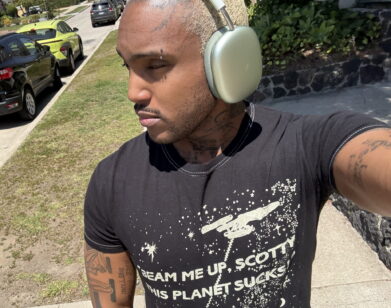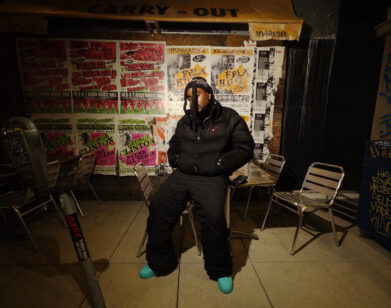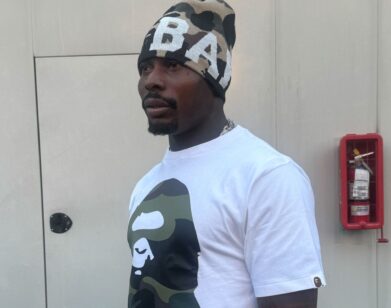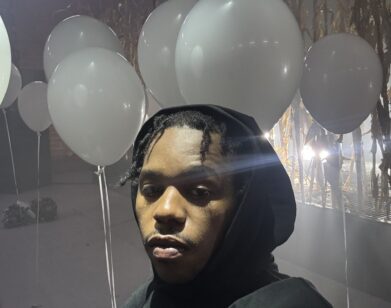Blockhead is Inspired by Public Access
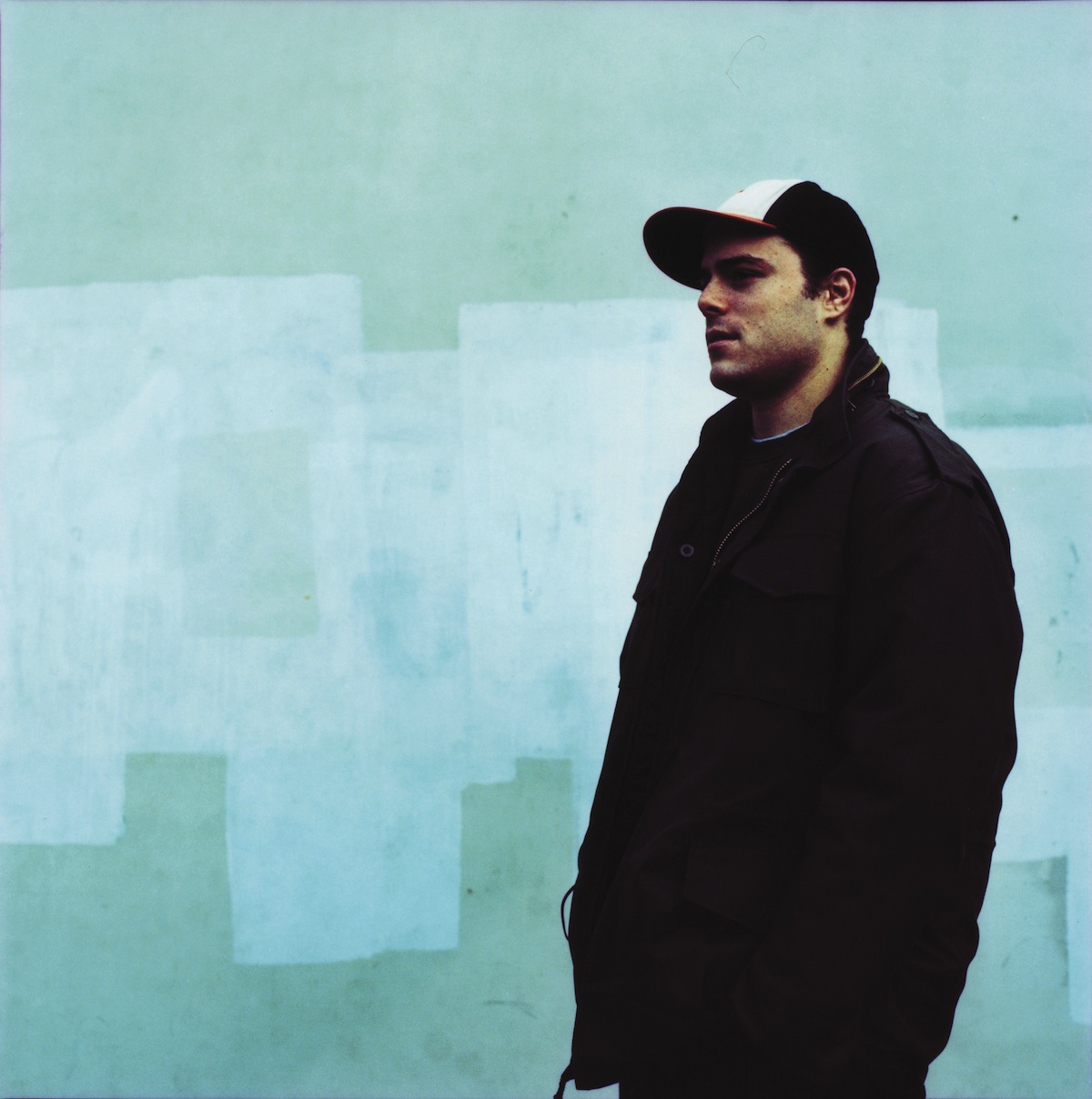
ABOVE: BLOCKHEAD. IMAGE COURTESY OF MAYA HAYUK
In a world where music is more and more like a science—made to be labeled, analyzed, and pulled apart—Tony Simon, aka Blockhead, keeps the soul in his sound. As a one-man act—producer, musician, and DJ—Blockhead has played his part in a variety of projects over the years, his most recent path leading him to a fifth studio album with independent UK label Ninja Tune, titled Interludes After Midnight. Debuting three years after the release of his last album (The Music Scene), Interludes After Midnight is a second wind for Blockhead, an expression of Simon’s trip down memory lane back to youthful, carefree years. With a unique aptitude for layering mixed beats upon vocal samples, his jazz-era-harmonics-meets 1990’s-Bed-Stuy-hip-hop approach fits any craving new listeners might have for an old-time groove.
Currently on tour opening for Conspirator, Blockhead will be traveling to New York on April 28 for a show at Irving Plaza. From collaborations with rappers across the country to the formation of a new group altogether, Blockhead is perpetuating a quickly evolving musical landscape for himself.
AVERIE TIMM: How did you get started as a musician?
TONY SIMON: I started rapping in the early, mid-’90s but I was also interested in production. As I went on, I realized that rapping wasn’t really going to pan out for me, so I stuck with production. Then around ’94 or ’95, I met Aesop Rock, who is a rapper I ended up working with later, and basically just saw him rap and knew I was better suited for the other side of things. I managed to start writing with him the late ’90s and then it lead to, you know, the next thing and the next thing and then by 2002 I was signed to Ninja Tune. That’s pretty much the whole thing.
TIMM: It seems like nowadays there’s a lot of genre-crossing going on; music doesn’t necessarily fit into categories anymore. How would you describe the music that you create? Do you find that it crosses the boundaries of electronica, jazz, hip-hop, etc.?
SIMON: It’s funny, I still consider it instrumental hip-hop because that’s where I’m coming from. I’m coming from a hip-hop background. I’m not really an electronic music guy, I don’t really listen to a lot of electronic music in general. I don’t dislike it, but it’s just not really my thing. I like vocals, and everything’s kind of born out of my own shit. I mix beats the same way now that I did when I started. The process hasn’t changed that much over the years.
TIMM: Are all of the sounds on your albums created using music software, or do you work with live instruments?
SIMON: I sample a lot, and there’s some live instruments. It’s kind of a mishmash of a lot of things. The majority of it is samples that are played with. I manipulate samples and then add some live instruments, then I’ll play some Moog sounds over it. But it’s basically a collage work of different sounds from all different sources.
TIMM: Talk to me a little bit about your evolution as an artist. It seems like, throughout your albums, you’ve stayed true to your own aesthetic. When you approached a new album three years after the last one, do you think the game had changed?
SIMON: It definitely had. But I’ve never really paid attention to it, because music is constantly changing. If I was to follow a trend, you’re just setting yourself up for a lack of longevity. All these things that are popular now aren’t going to be popular in three years. If I had set out to make this album three years ago and made it sound like what was popular then it would be totally worthless now, you know. Sticking with my style of music, I don’t want to say it’s timeless, but it’s something that’s not going to play out. It’s in the ether.
TIMM: Your fifth album off Ninja Tune, Interludes After Midnight, is coming out in a few weeks; what was your process like for writing and producing this album?
SIMON: It was hard, you know. Every time you start a new album it’s kind of like this undertaking, you just have to take a big breath and say, “Okay, now I gotta do this.” For me, I’m constantly creating stuff, and when it’s time to make music, I dig into that pot of stuff that I’ve already created and pick up the pieces I want to work with. When it’s time to make an album, it’s like making a jambalaya of different songs and hoping that everything works out. It’s a lot more work than it is fun. It’s a lot more mathematic, it’s a process. Going into this I just took a deep breath, and said, “Let me start this.” And then as you start, it gets rolling and everything works itself out.
TIMM: I recently read an article about your new album on Ninja Tune, and it talked about how it was inspired by “a time before cell phones, TiVo, and the Internet” existed. It said, “A simpler time has informed the sonic landscape of the album.” Are you, as they say, returning to a place that defined your upbringing? Are you going back in order to go forward?
SIMON: Well, not as far as how I made it. It has nothing to do with the process of making it, that’s more so the feeling I get from it. There’s kind of a throwback vibe to it, in the sense that something feels familiar about it, but I didn’t make an album to sound like it was made in 1992. I was trying to make an album that brings back similar feelings that I had during that time, which was a really informative time in my life, the late ‘80s to the mid/late ‘90s. Just growing up in New York and hanging out with my friends, there were really no responsibilities and it was just kind of a different lifestyle altogether. This album is kind of an ode to those days. The title is based off the TV show that was on public access in that era. It was a creepy, semi-pornographic TV show. And then, a lot of the songs are old titles of public-access TV shows.
TIMM: Do you think growing up in NYC affected this album more than the others?
SIMON: I mean, New York is going to affect every album. This one and the second were where I had New York in mind most. I don’t really know why that happened, it’s kind of one of those things where you have to take a step back for a minute and try to make sense of it all. I didn’t set out to make an album about New York in ’95, but when I stepped back I thought it gave me the feeling of when I was younger. As an older guy, it’s rare to get anything like that; a déjà vu feeling.
TIMM: The video by Anthony Francisco Schepperd for your 2009 track “The Music Scene” takes place in a post-apocalyptic world where only animals and TVs are left. Did you work closely with Schepperd in the creation of the video?
SIMON: I’d like to lie and say that I did, but I really didn’t. Ninja Tune called me up and said they were going to have a guy animate a video for me, then that video showed up in my email and I was just floored by it. I’ve never met Anthony, but it was easily the best thing I’ve been involved with. I can’t really wrap my head around how good it was. There’s so much going on, and it’s all hand-drawn.
TIMM: Your dad was a sculptor; do you think a visual thread runs through your music?
SIMON: I think the mindset of being an artist is what stayed with me the most. It’s weird, growing up with an artist father I was around galleries a lot and art shows and artists. But it didn’t really take with me, a lot of it. I didn’t really like art that much, it was kind of just “ugh.” It rubbed me the wrong way. But seeing someone who made a career out of art, and knowing that’s something you can actually do, had a much bigger effect on me than the actual pieces of art themselves. Seeing that as a possibility versus having lawyers as parents, it would be a lot different.
TIMM: You mentioned earlier that you’ve collaborated with a really impressive mix of artists: Aesop Rock, Smash, Slug, Murs. Do you have any other collaborations planned this year?
SIMON: In the last year or so I’ve started to seek out rappers that I personally enjoy, kind of under-the-radar guys. I’m doing some EPs and maybe albums with a bunch of different guys. This guy named Billy Woods from Brooklyn, Open Mike Eagle from LA, and another guy named MarQ Spekt from Philly. Oh, and Illogic from Columbus, Ohio. We’re doing a bunch of stuff together. I’m just trying to put out as much stuff as I possibly can with people who I admire. I’m also working with a female vocalist named Joanna Erdos. We have a group, it’s me and her and two other guys, The Mighty Jones. We’re putting together a 10-song album.
TIMM: Looking towards the future, where do you plan to go from here?
SIMON: I’m in New York right now, I’m doing a three-day day opening set for Conspirator in Albany, Philly, and New York so that should be fun. I’m going to try to do up shows and maybe get on some festivals, and just work on all these little projects I have. Whenever I finish a new album I need to just step back from that music for a while and start over a little bit. So, just working on these projects and hopefully getting a lot of my stuff out, playing shows, and traveling. You know . . . livin’ that life.
INTERLUDES AFTER MIDNIGHT IS OUT MAY 1. BLOCKHEAD WILL PLAY APRIL 28 AT IRVING PLAZA. FOR MORE ON THE MUSICIAN, VISIT HIS MYSPACE.

